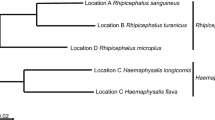Abstract
Ticks are well known as vectors of many viruses which usually do great harm to human and animal health. Yunnan Province, widely covered by flourishing vegetation and mainly relying on farming husbandry, is abundant with Rhipicephalus microplus ticks. Therefore, it is of great significance to characterize the viral profile present in R. microplus parasitizing on cattle in Yunnan Province. In this study, a total of 7387 R. microplus ticks were collected from cattle and buffalo in the northwest and southeast areas of Yunnan Province from 2015 to 2017. We investigated the virome of R. microplus using next-generation sequencing (NGS) and the prevalence of important identified viruses among tick groups by RT-PCR. It revealed the presence of diverse virus concerning chu-, rhabdo-, phlebo-, flavi- and parvo- viruses in Yunnan. These viruses consist of single-stranded, circular and segmented sense RNAs, showing a greatly diversity in genomic organization. Furthermore, continuous epidemiological survey among ticks reveals broad prevalence of three viruses (Yunnan mivirus 1, Wuhan tick vrius 1 and YN tick-associated phlebovirus 1) and two possible prevalent viruses including a flavivirus-like segmented virus (Jingmen tick virus) and a bovine hokovirus 2 in Yunnan. Serological investigation among cattle indicates that these identified viruses may be infectious to cattle and can elicit corresponding antibody. Our findings on R. microplus-associated viral community will contribute to the prevention of viral disease and tracking the viral evolution. Further analysis is needed to better elucidate the pathogenicity and natural circulation of these viruses.




Similar content being viewed by others
References
Bourhy H, Cowley JA, Larrous F, Holmes EC, Walker PJ (2005) Phylogenetic relationships among rhabdoviruses inferred using the L polymerase gene. J Gen Virol 86:2849–2858
Brinkmann A, Dincer E, Polat C, Hekimoglu O, Hacioglu S, Foldes K, Ozkul A, Oktem IMA, Nitsche A, Ergunay K (2018) A metagenomic survey identifies Tamdy orthonairovirus as well as divergent phlebo-, rhabdo-, chu- and flavi-like viruses in Anatolia, Turkey. Ticks Tick Borne Dis 9:1173–1183
Chen ZYX, Yang XH, Liu JZ (2008) Geographical distribution and Fauna of Chinese Ticks[in Chinese]. Sichuan J Zool 27:4
Cibulski SP, Teixeira TF, Dos Santos HF, de Sales Lima FE, Scheffer CM, Varela AP, de Lima DA, Schmidt C, Silveira F, de Almeida LL, Roehe PM (2016) Ungulate copiparvovirus 1 (bovine parvovirus 2): characterization of a new genotype and associated viremia in different bovine age groups. Virus Genes 52(1):134–137
Cotmore SF, Agbandje-McKenna M, Chiorini JA, Mukha DV, Pintel DJ, Qiu J, Soderlund-Venermo M, Tattersall P, Tijssen P, Gatherer D, Davison AJ (2014) The family Parvoviridae. Arch Virol 159:1239–1247
Dinçer E, Hacıoğlu SA-O, Kar S, Emanet N, Brinkmann A, Nitsche A, Özkul AA-O, Linton YM, Ergünay KA-O (2019) Survey and characterization of jingmen tick virus variants. Viruses 11:1071
Emmerich P, Jakupi X, von Possel R, Berisha L, Halili B, Gunther S, Cadar D, Ahmeti S, Schmidt-Chanasit J (2018) Viral metagenomics, genetic and evolutionary characteristics of Crimean-Congo hemorrhagic fever orthonairovirus in humans, Kosovo. Infect Genet Evol 65:6–11
Gómez GF, Isaza JP, Segura JA, Alzate JF, Gutiérrez LA (2020) Metatranscriptomic virome assessment of Rhipicephalus microplus from Colombia. Ticks Tick Borne Dis 11:101426
Grabherr MG, Haas BJ, Yassour M, Levin JZ, Thompson DA, Amit I, Adiconis X, Fan L, Raychowdhury R, Zeng Q, Chen Z, Mauceli E, Hacohen N, Gnirke A, Rhind N, di Palma F, Birren BW, Nusbaum C, Lindblad-Toh K, Friedman N, Regev A (2011) Full-length transcriptome assembly from RNA-Seq data without a reference genome. Nat Biotechnol 29:644–652
Horak IG, Camicas JL, Keirans JE (2002) The Argasidae, Ixodidae and Nuttalliellidae (Acari: Ixodida): a world list of valid tick names. Exp Appl Acarol 28:27–54
Huson DH, Auch AF, Qi J, Schuster SC (2007) MEGAN analysis of metagenomic data. Genome Res 17:377–386
Jia N, Liu HB, Ni XB, Bell-Sakyi L, Zheng YC, Song JL, Li J, Jiang BG, Wang Q, Sun Y, Wei R, Yuan TT, Xia LY, Chu YL, Wei W, Li LF, Ye JL, Lv QY, Cui XM, Guan Y, Tong YG, Jiang JF, Lam TT, Cao WC (2019) Emergence of human infection with Jingmen tick virus in China: A retrospective study. EBioMedicine 43:317–324
Jia N, Wang J, Shi W, Du L, Sun Y, Zhan W, Jiang J-F, Wang Q, Zhang B, Ji P, Bell-Sakyi L, Cui X-M, Yuan T-T, Jiang B-G, Yang W-F, Lam TT-Y, Chang Q-C, Ding S-J, Wang X-J, Zhu J-G, Ruan X-D, Zhao L, Wei J-T, Ye R-Z, Que TC, Du C-H, Zhou Y-H, Cheng JX, Dai P-F, Guo W-B, Han X-H, Huang E-J, Li L-F, Wei W, Gao Y-C, Liu J-Z, Shao H-Z, Wang X, Wang C-C, Yang T-C, Huo Q-B, Li W, Chen H-Y, Chen S-E, Zhou L-G, Ni X-B, Tian J-H, Sheng Y, Liu T, Pan Y-S, Xia L-Y, Li J, Zhao F, Cao W-C (2020) Large-scale comparative analyses of tick genomes elucidate their genetic diversity and vector capacities. Cell. https://doi.org/10.1016/j.cell.2020.07.023
Kortekaas J, Oreshkova N, Cobos-Jimenez V, Vloet RP, Potgieter CA, Moormann RJ (2011) Creation of a nonspreading Rift Valley fever virus. J Virol 85:12622–12630
Labuda M, Nuttall PA (2004) Tick-borne viruses. Parasitology 129(Suppl):S221-245
Langmead B, Salzberg SL (2012) Fast gapped-read alignment with Bowtie 2. Nat Methods 9:357–359
Li CX, Shi M, Tian JH, Lin XD, Kang YJ, Chen LJ, Qin XC, Xu J, Holmes EC, Zhang YZ (2015) Unprecedented genomic diversity of RNA viruses in arthropods reveals the ancestry of negative-sense RNA viruses. Elife 4:e05378
Maruyama SR, Castro-Jorge LA, Ribeiro JM, Gardinassi LG, Garcia GR, Brandao LG, Rodrigues AR, Okada MI, Abrao EP, Ferreira BR, Fonseca BA, Miranda-Santos IK (2014) Characterisation of divergent flavivirus NS3 and NS5 protein sequences detected in Rhipicephalus microplus ticks from Brazil. Mem Inst Oswaldo Cruz 109:38–50
Moming A, Yue X, Shen S, Chang C, Wang C, Luo T, Zhang Y, Guo R, Hu Z, Zhang YA, Deng FA, Sun SA (2018) Prevalence and phylogenetic analysis of Crimean-Congo hemorrhagic fever virus in ticks from different ecosystems in Xinjiang, China. Virol Sin 33:67–73
Parizi LF, Sabadin GA, Alzugaray MF, Seixas A, Logullo C, Konnai S, Ohashi K, Masuda A, da Silva Vaz JI (2015) Rhipicephalus microplus and Ixodes ovatus cystatins in tick blood digestion and evasion of host immune response. Parasites Vectors 8:122
Qin XC, Shi M, Tian JH, Lin XD, Gao DY, He JR, Wang JB, Li CX, Kang YJ, Yu B, Zhou DJ, Xu J, Plyusnin A, Holmes EC, Zhang YZ (2014) A tick-borne segmented RNA virus contains genome segments derived from unsegmented viral ancestors. Proc Natl Acad Sci U S A 111:6744–6749
Shi J, Hu Z, Deng F, Shen S (2018) Tick-Borne Viruses. Virol Sin 33:21–43
Shi M, Lin XD, Vasilakis N, Tian JH, Li CX, Chen LJ, Eastwood G, Diao XN, Chen MH, Chen X, Qin XC, Widen SG, Wood TG, Tesh RB, Xu J, Holmes EC, Zhang YZ (2016) Divergent viruses discovered in arthropods and vertebrates revise the evolutionary history of the flaviviridae and related viruses. J Virol 90:659–669
Souza WM, Fumagalli MJ, Torres Carrasco AO, Romeiro MF, Modha S, Seki MC, Gheller JM, Daffre S, Nunes MRT, Murcia PR, Acrani GO, Figueiredo LTM (2018) Viral diversity of Rhipicephalus microplus parasitizing cattle in southern Brazil. Sci Rep 8:16315
Stockman S (1918) Louping-ill. J Comp Pathol Ther 31:137–193
Tamura K, Stecher G, Peterson D, Filipski A, Kumar S (2013) MEGA6: molecular evolutionary genetics analysis version 6.0. Mol Biol Evol 30:2725–2729
Tokarz R, Williams SH, Sameroff S, Sanchez Leon M, Jain K, Lipkin WI (2014) Virome analysis of Amblyomma americanum, Dermacentor variabilis, and Ixodes scapularis ticks reveals novel highly divergent vertebrate and invertebrate viruses. J Virol 88:11480–11492
Vandegrift K, Kumar A, Sharma H, Murthy S, Kramer L, Ostfeld R, Hudson P, Kapoor A (2020) Presence of segmented flavivirus infections in north America. Emerg Infect Dis J 26:1810
Wang T, Sun Y, Qiu HJ (2018) African swine fever: an unprecedented disaster and challenge to China. Infect Dis Poverty 7:111
Wang Z-D, Wang B, Wei F, Han S-Z, Zhang L, Yang Z-T, Yan Y, Lv X-L, Li L, Wang S-C, Song M-X, Zhang H-J, Huang S-J, Chen J, Huang F-Q, Li S, Liu H-H, Hong J, Jin Y-L, Liu Q (2019) A new segmented virus associated with human febrile illness in China. New Engl J Med 380:2116–2125
Wichgers Schreur PJ, Kortekaas J (2016) Single-molecule fish reveals non-selective packaging of rift valley fever virus genome segments. PLoS Pathog 12:e1005800
Xia H, Hu C, Zhang D, Tang S, Zhang Z, Kou Z, Fan Z, Bente D, Zeng C, Li T (2015) Metagenomic profile of the viral communities in Rhipicephalus spp. ticks from Yunnan China. PLoS ONE 10:e0121609
Xu F, Pan Y, Wang M, Wu X, Tian L, Baloch AR, Zeng Q (2016) First detection of ungulate tetraparvovirus 1 (bovine hokovirus 1) in domestic yaks in northwestern China. Arch Virol 161:177–180
Zhan J, Wang Q, Cheng J, Hu B, Li J, Zhan F, Song Y, Guo D (2017) Current status of severe fever with thrombocytopenia syndrome in China. Virol Sin 32:51–62
Zhang Y, Shen S, Fang Y, Liu J, Su Z, Liang J, Zhang Z, Wu Q, Wang C, Abudurexiti A, Hu Z, Zhang Y, Deng F (2018) Isolation, characterization, and phylogenetic analysis of two new Crimean-Congo hemorrhagic fever virus strains from the northern region of Xinjiang Province, China. Virol Sin 33:74–86
Zhang Y, Shen S, Shi J, Su Z, Li M, Zhang W, Li M, Hu Z, Peng C, Zheng X, Deng F (2017) Isolation, characterization, and phylogenic analysis of three new severe fever with thrombocytopenia syndrome bunyavirus strains derived from Hubei Province, China. Virol Sin 32:89–96
Zhang Y, Si BY, Liu BH, Chang GH, Yang YH, Huo QB, Zheng YC, Zhu QY (2012) Complete genomic characterization of two tick-borne encephalitis viruses isolated from China. Virus Res 167:310–313
Zhao T, Gong H, Shen X, Zhang W, Shan T, Yu X, Wang SJ, Cui L (2020) Comparison of viromes in ticks from different domestic animals in China. Virol Sin 35:398–406
Zou Z, Liu J, Wang Z, Deng F, Wang H, Hu Z, Wang M, Zhang T (2016) Characterization of two monoclonal antibodies, 38F10 and 44D11, against the major envelope fusion protein of Helicoverpa armigera nucleopolyhedrovirus. Virol Sin 31:490–499
Aknowledgements
This work was jointly funded by the Scientific and Technological Basis Special Project grant (2013FY113500) from the Ministry of Science and Technology of China, the National Natural Science Foundation of China (81874274 and 81660558), the National Science and Technology Major Project on Important Infectious Diseases Prevention and Control (2018ZX10734-404), and the Yunnan Health Training Project of High Level Talents (L-2017027).
Author information
Authors and Affiliations
Contributions
SS, YZ and FD conceived and designed the experiments. JS, and HW performed the experiments. JS, SS and FD wrote the paper. YZ and FD finalized the manuscript. All authors have read and approved the final manuscript.
Corresponding authors
Ethics declarations
Conflict of interest
The authors declare that they have no conflicts of interest.
Animal and Human Rights
Collections of ticks and serum of cattles were approved by the Medical Ethics Committee of Dali University. Human serum samples were collected from patients and healthy volunteers with informed consent. All the procedures performed in studies involving animals were in accordance with the ethical standards of the Animal Care and Ethics Committees of Wuhan institute of virology, CAS (Approval numbers WIVA01201601).
Electronic supplementary material
Below is the link to the electronic supplementary material.
Rights and permissions
About this article
Cite this article
Shi, J., Shen, S., Wu, H. et al. Metagenomic Profiling of Viruses Associated with Rhipicephalus microplus Ticks in Yunnan Province, China. Virol. Sin. 36, 623–635 (2021). https://doi.org/10.1007/s12250-020-00319-x
Received:
Accepted:
Published:
Issue Date:
DOI: https://doi.org/10.1007/s12250-020-00319-x




